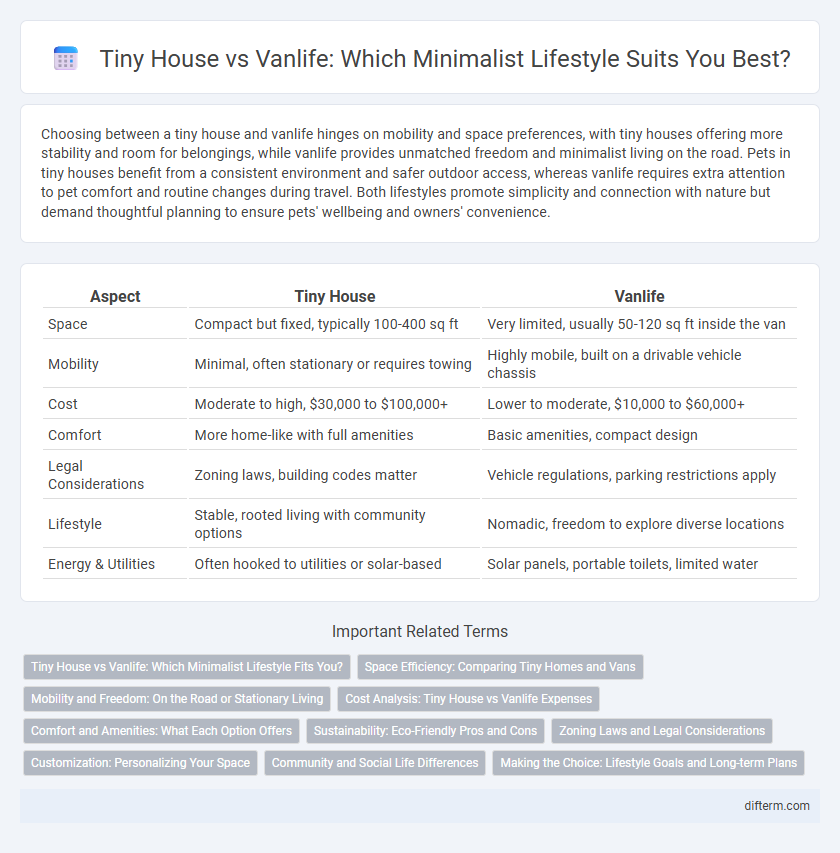Choosing between a tiny house and vanlife hinges on mobility and space preferences, with tiny houses offering more stability and room for belongings, while vanlife provides unmatched freedom and minimalist living on the road. Pets in tiny houses benefit from a consistent environment and safer outdoor access, whereas vanlife requires extra attention to pet comfort and routine changes during travel. Both lifestyles promote simplicity and connection with nature but demand thoughtful planning to ensure pets' wellbeing and owners' convenience.
Table of Comparison
| Aspect | Tiny House | Vanlife |
|---|---|---|
| Space | Compact but fixed, typically 100-400 sq ft | Very limited, usually 50-120 sq ft inside the van |
| Mobility | Minimal, often stationary or requires towing | Highly mobile, built on a drivable vehicle chassis |
| Cost | Moderate to high, $30,000 to $100,000+ | Lower to moderate, $10,000 to $60,000+ |
| Comfort | More home-like with full amenities | Basic amenities, compact design |
| Legal Considerations | Zoning laws, building codes matter | Vehicle regulations, parking restrictions apply |
| Lifestyle | Stable, rooted living with community options | Nomadic, freedom to explore diverse locations |
| Energy & Utilities | Often hooked to utilities or solar-based | Solar panels, portable toilets, limited water |
Tiny House vs Vanlife: Which Minimalist Lifestyle Fits You?
Choosing between a tiny house and vanlife depends on your mobility needs and space preferences; tiny houses offer stable, customizable living with more room, while vanlife provides unparalleled freedom to travel and explore. Tiny houses often feature permanent setups with utilities and storage, ideal for those valuing comfort and community. Vanlife suits adventurous individuals who prioritize flexibility and minimalist essentials over extensive living space.
Space Efficiency: Comparing Tiny Homes and Vans
Tiny houses utilize fixed, compact layouts optimized for maximal storage and multi-functional furniture, achieving efficient use of limited square footage in stationary settings. Vans require highly adaptable, foldable solutions to maximize space within a mobile framework, often incorporating convertible beds and modular storage. Both lifestyles prioritize minimalist living, but tiny homes offer more dedicated zones while vans demand versatile, space-saving designs due to restricted interior dimensions.
Mobility and Freedom: On the Road or Stationary Living
Tiny houses offer a stationary living experience with the freedom to customize and create a stable home environment, while vanlife emphasizes mobility and constant travel, allowing for spontaneous exploration and adaptability. Vanlife prioritizes compact, efficient use of space and easy access to remote locations, whereas tiny houses provide more space and amenities but require relocation planning. The choice between tiny houses and vanlife depends on whether one values permanence and comfort or flexibility and adventure.
Cost Analysis: Tiny House vs Vanlife Expenses
Tiny house living typically involves upfront construction costs ranging from $30,000 to $60,000, with ongoing expenses including property taxes, utilities, and maintenance averaging $200 to $400 monthly. Vanlife offers lower initial costs, often between $10,000 and $25,000 for van conversion, but variable expenses include fuel, campground fees, and vehicle maintenance, averaging around $150 to $300 monthly. Overall, vanlife tends to have lower entry and operating costs, while tiny houses incur higher fixed costs but may offer more stability and potential long-term savings.
Comfort and Amenities: What Each Option Offers
Tiny houses provide a higher level of comfort with permanent structures that include full-sized kitchens, bathrooms, and living areas, allowing for a home-like environment. Vanlife offers mobility and flexibility but sacrifices some amenities, typically featuring compact cooking setups, limited storage, and improvised sleeping quarters. Both lifestyles prioritize minimalism, yet tiny houses excel in providing consistent comfort and convenience through robust utilities and space customization.
Sustainability: Eco-Friendly Pros and Cons
Tiny houses often use sustainable materials like reclaimed wood and incorporate solar panels, reducing their environmental footprint with efficient insulation and low energy consumption. Vanlife offers mobility with a smaller living space that encourages minimalism, yet limited resource management and reliance on generator power can increase carbon emissions. Both lifestyles promote eco-friendly living but require mindful practices to maximize sustainability benefits.
Zoning Laws and Legal Considerations
Zoning laws heavily impact the feasibility of living in tiny houses versus vans, as many municipalities restrict permanent dwellings on private land, affecting tiny house placements. Vanlife offers greater legal flexibility since vehicles are subject to different regulations, allowing for more mobility without zoning permits. However, both lifestyles require adherence to local parking restrictions and safety codes to avoid fines or displacement.
Customization: Personalizing Your Space
Tiny houses offer extensive customization options with fixed layouts, allowing for tailored built-in furniture, storage solutions, and personalized design elements that optimize every square inch. Vanlife customization prioritizes modular, flexible interiors using multi-functional furniture and adaptable storage to maximize limited space while enabling easy mobility. Both lifestyles emphasize personalizing the environment to reflect individual tastes and practical needs, but tiny houses provide more architectural freedom compared to the compact, versatile nature of van conversions.
Community and Social Life Differences
Tiny house living fosters a stable, close-knit community through established neighborhoods and local events, promoting consistent social interactions. Vanlife offers a fluid social experience with diverse encounters at campsites and festivals, encouraging broader but less stable connections. The contrast lies in tiny houses providing rooted community ties, while vanlife emphasizes mobility and varied social networks.
Making the Choice: Lifestyle Goals and Long-term Plans
Choosing between a tiny house and vanlife hinges on evaluating lifestyle goals such as the desire for mobility versus permanence and assessing long-term plans including stability, community connections, and environmental impact. Tiny houses offer a stationary, customizable living space supporting sustainability and rooted lifestyle, whereas vanlife emphasizes freedom, adventure, and minimalism with the flexibility to explore diverse locations. Prioritizing factors like work needs, family considerations, and financial sustainability informs how each option aligns with personal values and future aspirations.
tiny house vs vanlife Infographic

 difterm.com
difterm.com